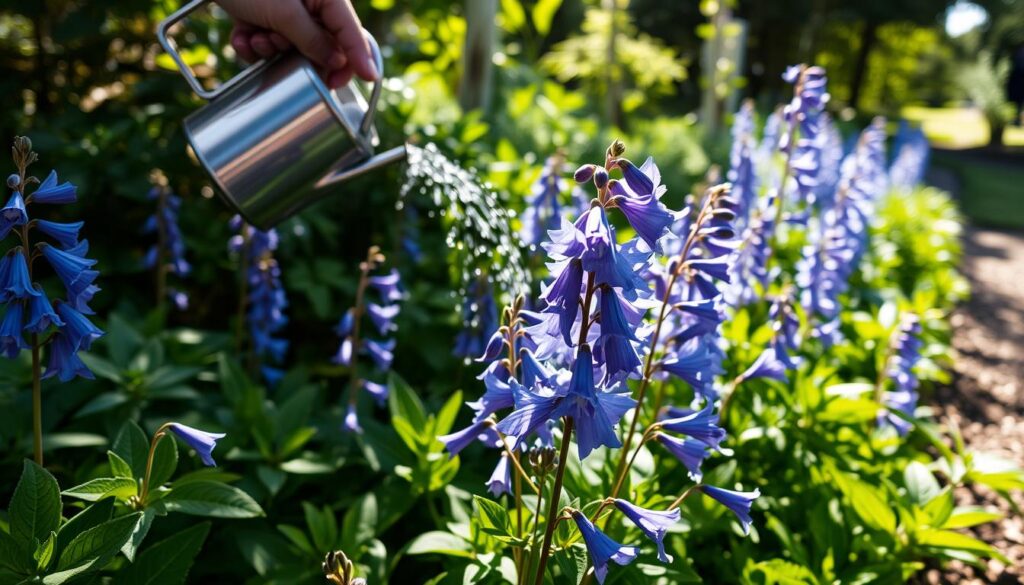Did you know the Campanula genus has over 500 species? Among them, Campanula medium is a standout. It’s a biennial plant, also known as Canterbury bells, growing 60-80 cm tall. It makes a beautiful addition to perennial flower beds.
I love flowering perennials, and Campanula medium is one of my favorites. Its big, bell-shaped flowers come in violet-blue, pink, or white. These hardy perennials bloom from May to July in the Northern Hemisphere, adding elegance to gardens.
Campanula medium is versatile in flower gardens. It does well in cool to warm zones and is found in many European countries and North America. I think these perennials look best when planted in large groups or among shrubs. They create a stunning display that catches everyone’s eye.
Key Takeaways
- Campanula medium reaches 60-80 cm in height
- Flowers bloom in shades of violet-blue, pink, or white
- Flowering period is from May to July in the Northern Hemisphere
- Best suited for cool or warm zones
- Ideal for massed planting in borders or among shrubs
- Naturalized in most European countries and North America
Introduction to Campanula Medium: Canterbury Bells
I’m excited to introduce you to Campanula Medium, also known as Canterbury Bells. These flowers are perfect for any garden, adding beauty with little upkeep. They’re great for gardeners who want to save water but still enjoy beautiful flowers.
Origin and History
Canterbury Bells have a long history, starting in the 16th century. They were first called Coventry Bells and quickly became popular in Britain. By the 1800s, they were known as Canterbury Bells, named after their popularity in the Canterbury area.
Botanical Description
Campanula Medium is part of the Campanulaceae family and comes from southern Europe. These plants grow to be 20-26 inches tall and 12-18 inches wide. They have bell-shaped flowers in colors like pink, white, purple, and blue, adding beauty to any garden.
Common Names and Varieties
Canterbury Bells are also known as Cup and Saucer or Bell Flower. Some popular types include:
- ‘Bells of Holland’: Known for its sturdy stems
- ‘Champion Pink’: Offers a delightful pink hue
- ‘Dwarf Bella Mix’: Perfect for smaller gardens
| Variety | Height | Bloom Color | Special Features |
|---|---|---|---|
| Canterbury Bells White | 32 inches | White | Drought-tolerant |
| Campanula Glomerata Superba | 20 inches | Purple | Long-blooming |
| Campanula Carpatica White | 8 inches | White | Compact growth |
| Campanula Medium Rose-pink | 24-26 inches | Rose-pink | Fragrant blooms |
Growing Conditions for Campanula Medium
I’m thrilled to share my experience with Campanula Medium, a beautiful plant for any cottage garden. These plants are great for pollinators and bloom beautifully year after year if you provide the right conditions.
Sunlight Requirements
Canterbury bells need plenty of sunlight. They do best with 4-6 hours of direct sunlight each day. In my garden in USDA hardiness zone 7, I place them where they get morning sun and afternoon shade. This protects them from the hottest part of the day.
Soil Preferences
These plants prefer soil that drains well and is loamy. I keep the soil’s pH between 5.8 and 6.2. Before planting, I add organic matter to the soil to help with drainage and fertility.
Water Needs
Campanula Medium needs consistent moisture to stay healthy. I water them deeply once a week, keeping the soil moist but not too wet. When it’s very hot, I water them more often to prevent stress.
| Factor | Ideal Conditions |
|---|---|
| Sunlight | 4-6 hours daily |
| Soil pH | 5.8 – 6.2 |
| Temperature | 55-60°F (13-15°C) |
| Spacing | 6″ apart |
| Watering | Weekly, deeply |
By giving these plants the best growing conditions, I’ve made a cottage garden full of lovely Canterbury bells. These plants attract pollinators and make visitors smile all summer.
Planting and Propagation Techniques
I love working with Canterbury bells, especially when it comes to planting and propagation. These beautiful flowers are perfect for naturalizing plants in your garden. To start, I sow seeds indoors in late winter using a tray filled with potting soil. I lightly cover the seeds with vermiculite and keep the temperature between 65-70°F.
Once the last frost has passed, I transplant the seedlings outdoors. For a continuous display of blooms, I plant new seeds every year. Canterbury bells work well in flower beds, borders, and containers. I typically place them in the second row of a three-row bed arrangement for the best visual impact.
For those interested in heirloom varieties, Canterbury bells offer some stunning options. These traditional cultivars often have unique characteristics that make them stand out in any garden setting.
Seed Germination Guide
Understanding seed germination is crucial for successful propagation. Here’s a helpful table showing optimal soil temperatures for various vegetables:
| Vegetable | Optimal Soil Temperature (°F) |
|---|---|
| Cabbage | 45-95 |
| Carrot | 45-85 |
| Lettuce | 40-80 |
| Tomato | 60-85 |
| Cucumber | 60-95 |
Remember, expect about 65% to 80% of new seeds to germinate, with 60% to 75% producing strong seedlings. This knowledge helps me plan my garden effectively, ensuring a beautiful display of Canterbury bells and other perennials year after year.
Campanula Medium Care and Maintenance
Caring for Canterbury bells is essential to enjoy their beauty. With simple steps, they become a great choice for your garden. They are easy to maintain.
Fertilization
In spring, I give my Canterbury bells a balanced 5-10-5 NPK fertilizer. This mix helps them grow strong without too much foliage. It’s crucial not to overdo it, or the stems might get weak and need staking.
Pruning and Deadheading
To keep my Canterbury bells looking great, I remove dead leaves all summer. Cutting off the spent flowers makes them bloom more from May to July. This keeps them looking good and helps them stay healthy.

Winter Protection
Winter care is key for Canterbury bells, especially their first year. I either keep them indoors or mulch them well when planting in spring. In cold areas, I water them lightly during frosts to help them survive.
| Care Aspect | Requirement |
|---|---|
| Sunlight | 4-6 hours daily |
| Soil pH | Neutral to alkaline |
| Watering | Regular, avoid waterlogging |
| Hardiness Zones | USDA 5-8 |
By following these tips, Canterbury bells can flourish in a low-maintenance garden. Their beautiful flowers add charm from late spring to early fall.
Companion Plants and Garden Design
I love making beautiful flower gardens that match the cottage garden look. When I design my garden, I think about planting together to make my plants healthier and prettier. Campanula Medium, or Canterbury Bells, goes great with other plants I like.
Canterbury Bells look amazing with Campanula carpatica, Phlox, or Syringa vulgaris. These plants together make my garden look good and bring in bees and butterflies. I like to plant Canterbury Bells in borders, near shrubs, or in big groups.
To make my garden full of life, I use different plants together. Here’s a table with some good plant pairings I’ve tried in my Southern California garden:
| Primary Plant | Companion Plants | Benefits |
|---|---|---|
| Tomatoes | Marigolds, Basil, Asparagus | Pest deterrence, Nematode protection |
| Squash | Marigolds, Nasturtiums | Repels squash bugs, Attracts pollinators |
| Eggplants | Catnip, Marigolds | Repels flea beetles, Deters pests |
| Artichokes | Peas, Sunflowers | Nutrient support, Sun relief |
Using these planting tips, I’ve made a cottage garden that’s both pretty and useful. The mix of flowers and veggies makes my garden look better and helps it stay healthy.
Perennial Flowers: Incorporating Campanula Medium
I adore adding Campanula Medium to my garden. These flowers add elegance and height. They work well with other perennials, making the garden look stunning every year.
Benefits of Campanula in Perennial Gardens
Campanula Medium brings many benefits to gardens. Their beautiful flowers draw in bees and butterflies. The sweet scent fills the air, making the garden a treat for the senses.
‘Rapido Blue’ campanula blooms early, adding to the garden’s beauty for longer.

Complementary Perennials
To make a beautiful garden, I choose plants that grow well together. Some great friends for Campanula Medium are:
- Other Campanula species
- Phlox
- Peach-Leaved Bellflower (Campanula persicifolia)
- Lily of the Valley (Convallaria majalis)
Campanula carpatica is perfect for USDA Hardiness Zones 3 to 9. It’s a great choice for adding texture and color to the garden.
“The combination of Campanula Medium with other bell-shaped flowers creates a symphony of shapes and colors in my garden.”
Adding Campanula Medium with these plants makes my garden lively and colorful. It keeps the garden interesting and beautiful all season.
Pest and Disease Management
As a gardener who loves drought-tolerant flowers and low-maintenance landscaping, I’ve learned that even tough plants like Canterbury bells need protection. These beauties can face challenges from pests and diseases. Let’s explore how to keep your Campanula Medium healthy and thriving.
Aphids, mites, slugs, and snails are common pests that can eat your Canterbury bells. To fight these pests, I use natural predators like ladybugs or organic insecticidal soaps. For slugs and snails, I set up barriers with copper tape or beer traps.
Fungal diseases like root rot, powdery mildew, and rust can also harm these plants. To prevent this, I make sure there’s good air flow, don’t overwater, and remove any affected parts quickly. Catching these problems early is crucial.
- Space plants well for good air flow
- Water plants at the base, avoiding wet leaves
- Remove dead or sick plant parts fast
- Use organic fungicides if needed
By adding these steps to your garden care, you’ll keep your drought-tolerant flowers looking great. Remember, preventing pests and diseases is easier than treating them. A little prevention can go a long way in keeping your garden healthy!
Campanula Medium in Container Gardens
I adore growing Canterbury bells in containers. It’s a simple way to beautify my gardens. These plants grow 60-100 cm tall and spread 20-40 cm, fitting well in pots. They’re perfect for easy landscaping, blooming from January to June in USDA Zones 3-9.
Choosing the Right Container
I choose pots with drainage holes for my Canterbury bells. They do well in containers at least 12 inches deep. I use regular potting soil, sometimes adding sand for better drainage. This setup helps them grow well, keeping the soil moist but not too wet.
Container Care Tips
Container-grown Canterbury bells need more water than those in the ground. I keep the soil consistently moist, especially when they’re flowering. Fertilizing every two weeks with a balanced feed keeps them healthy. For winter, I move the pots to a sheltered spot or wrap them in burlap.
With the right care, my potted Campanula Medium looks amazing in my gardens. They’re great for adding height to patios or balconies. They’re a versatile choice for any easy landscaping project.
FAQ
What are the origins and history of Campanula medium (Canterbury bells)?
What are the sunlight requirements for growing Canterbury bells?
How do I propagate and plant Canterbury bells?
What are the fertilization and pruning needs for Canterbury bells?
What companion plants and garden designs work well with Canterbury bells?
Can Canterbury bells be grown as perennials?
What pests and diseases affect Canterbury bells, and how can they be managed?
Can Canterbury bells be grown in containers?
Source Links
- Campanula medium
- Campanula – bell-like flowers signifying gratitude, faith and constancy
- Jim’s Favorite Campanula Flower Garden Seeds
- How to sow and care for Canterbury Bells | Garden guide to Campanula medium
- Canterbury Bells Seed – Campanula Medium White Flower Seeds
- Ring in the Summer With Canterbury Bells
- How to Grow Campanula (Canterbury Bells) for Cut Flowers
- How to sow and care for Canterbury Bells | Garden guide to Campanula medium
- Canterbury Bells Plant: How To Grow Canterbury Bells
- Plant Propagation – Cooperative Extension: Garden and Yard – University of Maine Cooperative Extension
- Grower 101: Propagating Herbaceous Perennials – Greenhouse Product News
- Perennial Propagation | Mississippi State University Extension Service
- CAMPANULA – Flowers We Love – Flower.Style Magazine
- Campanula: A Growing Guide for Bellflower Plant – Garden Design
- Companion Planting for Successful Southern California Vegetable Gardens – Fine Gardening
- Companion Planting: Flowers To Grow With Vegetables
- Perennial Solutions: Campanula carpatica ‘Rapido Blue’ – Greenhouse Product News
- 35 Stunning Plants With Bell-Shaped Flowers For Gardens This Spring
- Identification and Management of Diseases of Perennials in the Landscape
- Perennial Flowers & Environmental Problems – Millcreek Gardens
- Flowers and Ornamentals: Pests and Diseases | Penn State Extension
- How to sow and care for Canterbury Bells | Garden guide to Campanula medium
- Campanula or bellflowers for pots and planters


